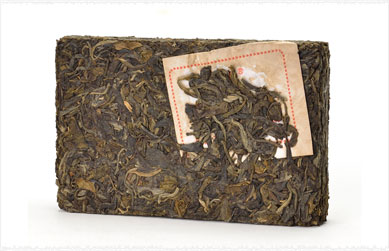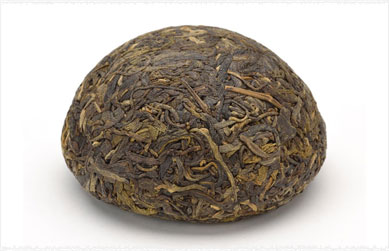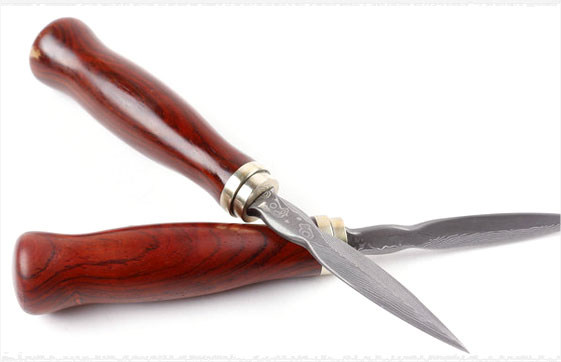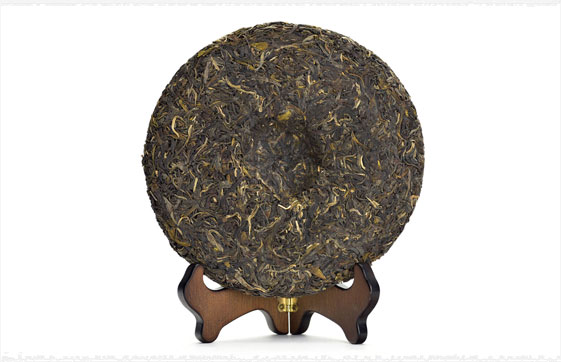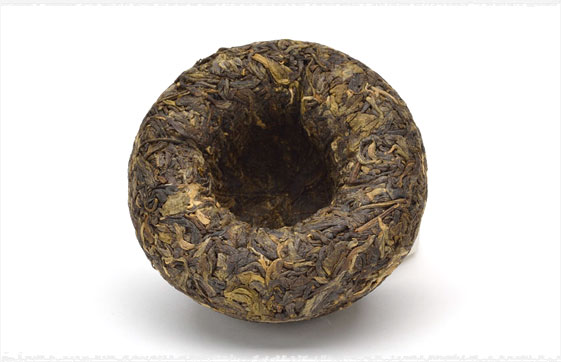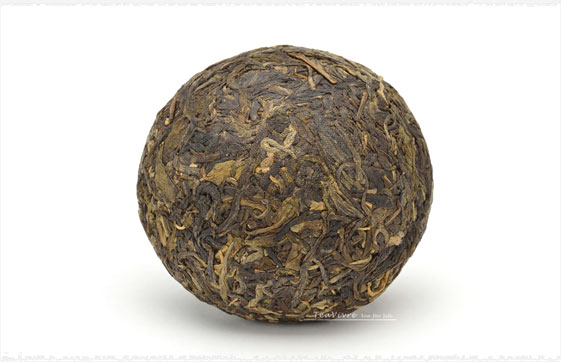Pu-erh tea is a type, or variety, of post-fermented tea produced primarily in the Yunnan Province of China. Pu-erh tea is very unique type of tea which tastes better as it ages.
Again, Pu-erh tea is a post-fermentation tea, which is a particular type of producing teas in which the tea leaves undergo a fine process of microbial fermentation after the tea leaves are dried and rolled. Pu-erh is usually a very highly fermented tea. You can purchase Pu-erh tea in loose leaf form but the traditional and most widely way to purchase Pu-erh tea is in brick or cake form, where they compress the tea leaves extremely tightly into the shape of a disc, brick, square, bird's nest or some other tightly compressed shape.
All types of Pu-erh (also sometimes called Puer, Pu-er or Pu'er) tea are created from Máochá which is a mostly unoxidized green tea which is produced a certain variety of the the Camellia Sinensis plant (commonly known as the tea tree) from a "large leaf" variety of Camellia found in the mountains of the southern Yunnan Province.
As mentioned, Pu-erh tea can be compressed into a variety of different shapes and almost any size. Some of the words for compressed Pu-erh are: Bing, Tuocha, Cake and Brick. These tightly compressed and extremely hard compressed Pu-erh teas which are uniquely produced by a process of pilling and pressing.
Therefore, because Pu-erh is available in a wide variety of shapes, but is so tightly compressed that it is very hard to pry the tea loose from, we need to learn how to properly remove and pry tea flakes from the compressed Pu-erh tea to be able to brew and drink the delicious Pu-erh tea!
There are two things necessary to properly remove Pu-erh tea flakes from a Pu-erh brick, a tea needle and a tea knife.
Traditionally one of the most common forms of Pu-erh tea is a thick, very hard, rectangular shaped tea brick, which most commonly comes in 100g, 250g, 500g and 1000g sizes. These bricks are called Zhuancha bricks and they are the traditional shape for compressed Pu-erh tea in China, used for easier transportation through the ancient tea routes by horse caravans.
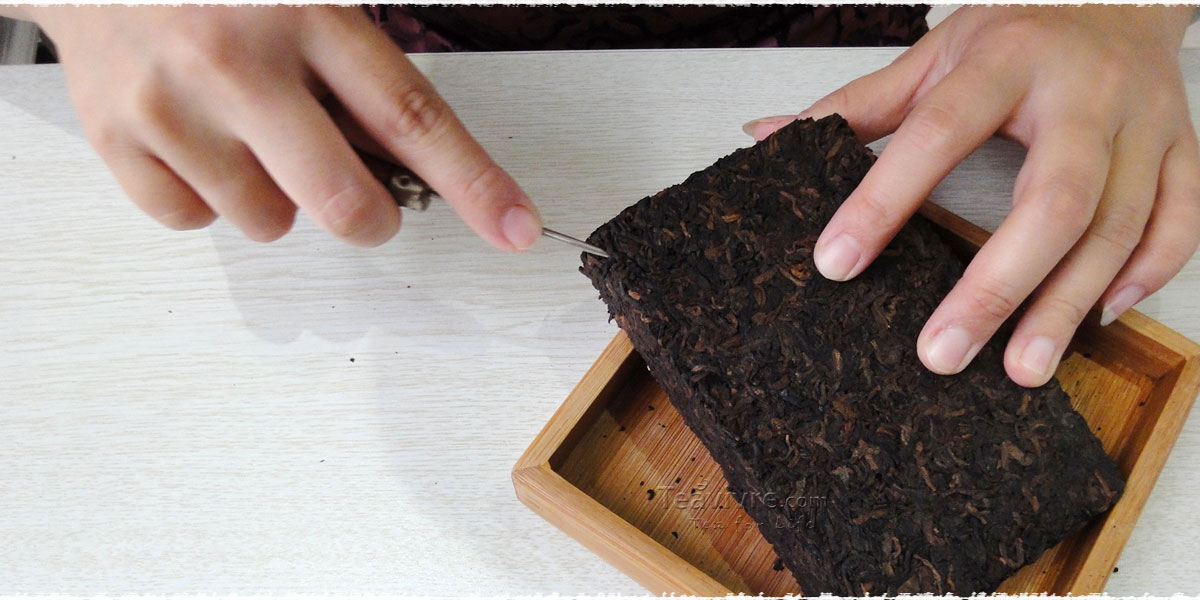
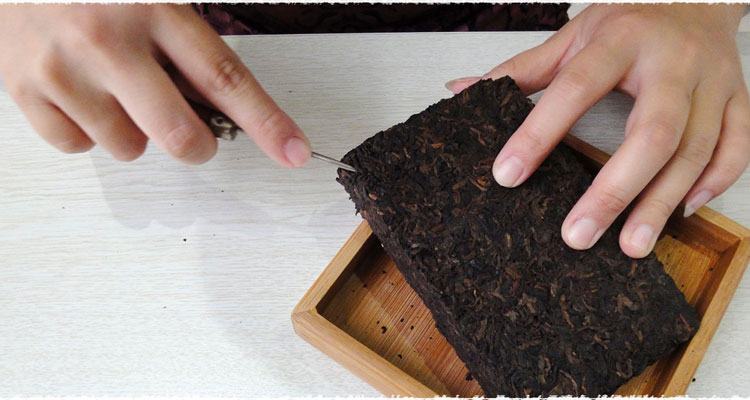
The first thing to do when prying tea flakes from a compressed Pu-erh brick is to pick one of its four corners to begin prying the tea from. Because each Pu-erh brick or cake is produced uniquely with different pilling and the tea being compressed in different way.
Because of this, when we begin to loosen our Pu-erh tea for brewing, we need to begin by inserting our tea needle into one of the four corners, where you can find an appropriate opening to insert your needle. Once you find a place in one of the corners that you can insert your tea needle, do so, and using the tea needle, rotate it and press it to insert the tea needle.
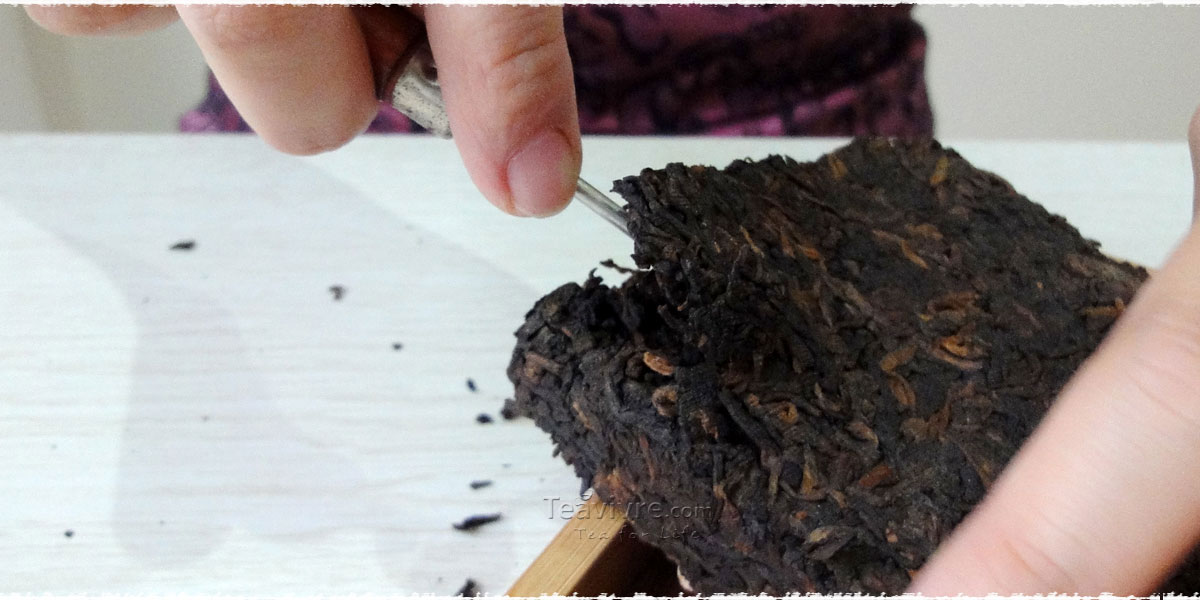
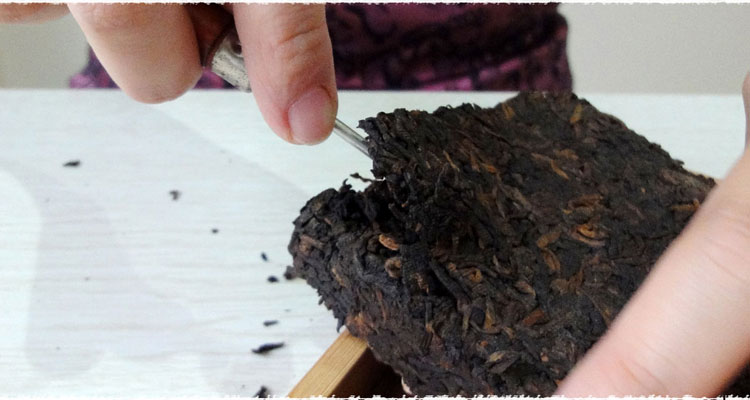
Next, find another place to insert your needle fairly close to where you have already inserted your needle the first time, and insert your needle into this second hole and again, rotate and press to loosen the tea.
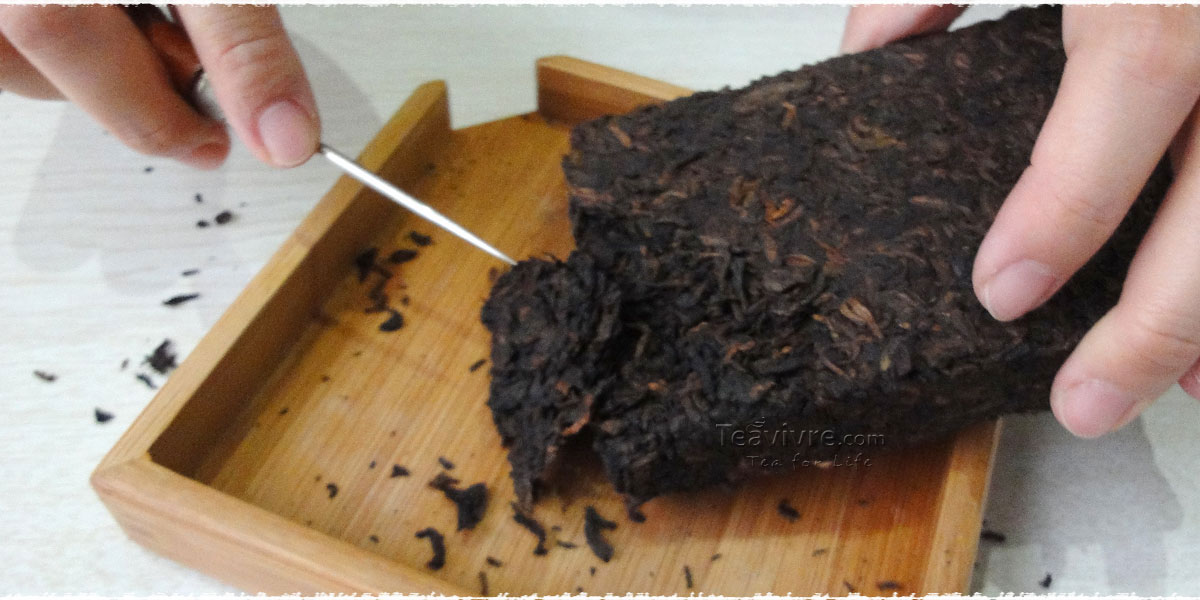
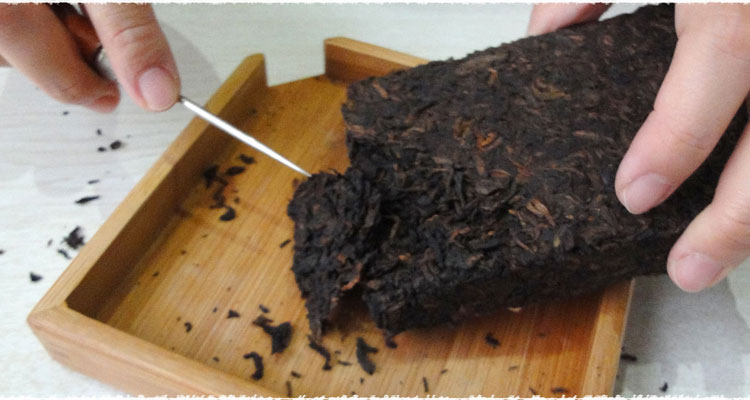
When you have inserted the tea needle the second time you can usually use the needle to chip off the corner of the brick using your two needle holes, and pry off the first piece of Pu-erh tea. If you are having difficulty prying your Pu-erh tea from the cake or brick, here are some tips to help you:
Pu-erh tea in brick form has a square or rectangular shape, and some may have a tea or manufacturer brand impressed directly into the tea cake. Therefore, when you are prying away the Pu-erh tea leaves you may choose to only pry away tea that is not branded or impressed upon so that it can be stored with most of the brick intact to show the beautiful impressions on the brick, which can sometimes be quite elaborate and unique.
Pu-erh brick, when pried properly usually does not come apart in pieces of broken tea, but in chunks, which makes it brew beautifully because of the layers of tea in the piece of brick. Each layer of tea has it's own flavor and unique attributes, and Pu-erh tea can be re-brewed many times for a different tea-drinking experience with every re-brewing.
When you end up prying enough tea from your Pu-erh brick to where there is little left, the brick becomes very thin and you can then simply use your hand to break up and separate the Pu-erh tea.
Sometimes when you try to insert your tea needle into the brick to separate the Pu-erh tea, you might meet with a lot of resistance, since compressed Pu-erh tea is extremely hard. So you may have to try inserting your tea needle into many different places around the tea brick or tea cake to find a place where you can actually insert the needle fully.
Bing and Tuocha Pu-erh — Two Types of Compressed
Pu-erh tea are called “Bing” and “Tuocha”. A Bing is usually a round, flat and disc or puck shaped tea brick and can range in size from 100g to as large as 5 kg or more. However the most common sizes for a Bing Pu-erh are 357g, 400g, and 500g. Bing Pu-erh tea can be compressed so that the edges of the compressed disk can be either rounded or perpendicular.
A Pu-erh tuocha (sometimes spelled 'tuo cha') is a convex, knob shaped tea, sometimes said to resemble a bird's nest. Pu-erh tuocha tea cakes range in size from a very tiny individual serving 3 grams, to upwards of 3 kilograms although the more common sizes for a Pu-erh tuocha are 100g, 250g and 500g. The nomenclature of the word “tuocha” is believed to have come from the rounded top-like shape of the compressed Pu-erh tea, or possibly from the historical tea trading route along the Toujiang River in China.
How to Pry and Remove Pu-erh Tea from Bing and Tuocha Pu-erh
Pu-erh Tuocha Tea Prying
Again you will need a tea needle to ideally remove the Pu-erh tea flakes from your tuocha Pu-erh. With a tuocha, turning the tea on its back and choose a concave edge to select the easiest place to insert your tea needle. You should be able to insert your tea needle at least 2/3 of the way through the tuocha, then use the tea needle to pry upon it lightly in order to loosen the tea from the tuocha.

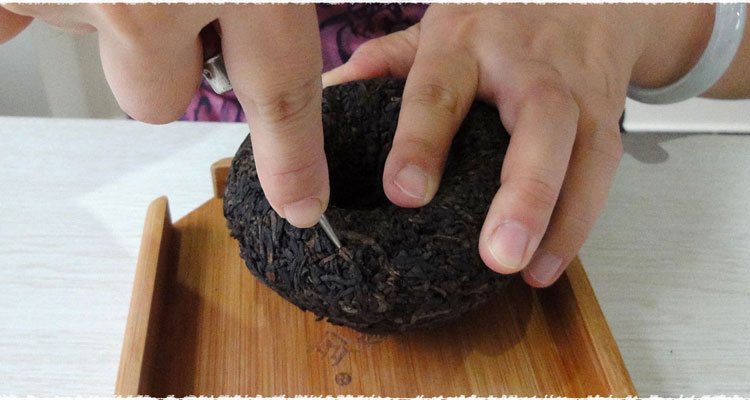
Then once again, you should find another place to insert your tea needle close to where you inserted the needle the first time, then repeat in 3 or 4 places near those two holes.

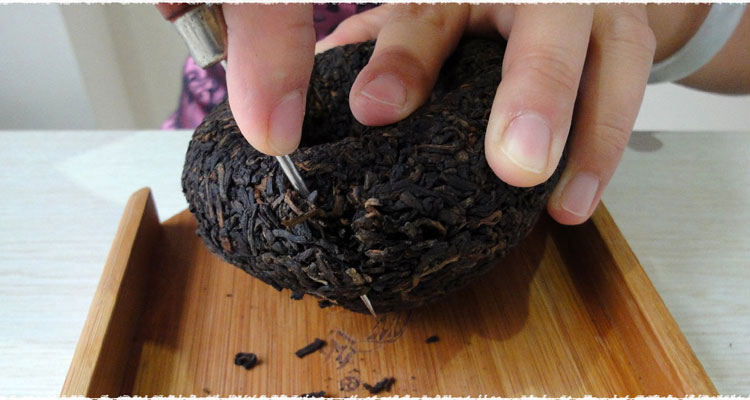
By using your tea needle in this way, the tuocha becomes easily separated, so that you can pry off the necessary amount to brew your Pu-erh tea. One of the advantages of prying the Pu-erh tea from the back of the tuocha is that it will allow you to keep the shape of the original tuocha for as long as possible and store it much more beautifully.

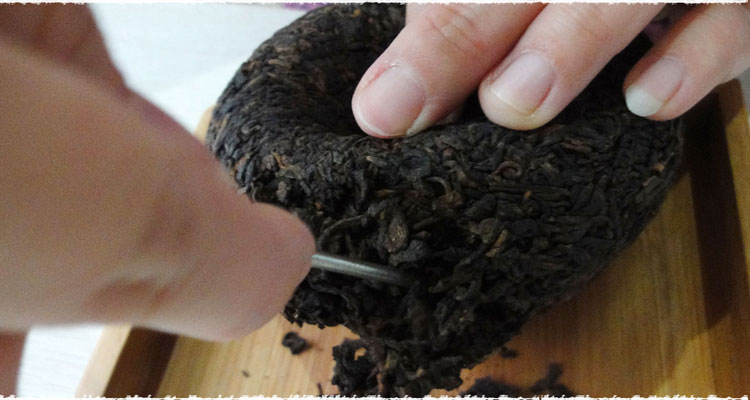
Prying and Removing Pu-erh from a Bing Pu-erh Tea Cake
Prying and removing Pu-erh tea leaves from a bing Pu-erh is much the same as prying leaves from a Pu-erh tuocha, so you can use the same needle insertion method to also pry the tea flakes from your Pu-erh bing. However, a bing Pu-erh is much more tightly compressed than a tuocha, so if you can not use your needle to pry the tea flakes out of your bing, then you may wish to use a tea knife instead.
It is always better to pry tea from the backside of your Pu-erh tea cakes rather than the face of the bing or tuocha so that it may retain its original shape and style for as long as possible, also allowing it to be stored properly.
The first step in removing Pu-erh tea flakes from a tightly compressed bing is to find a place that you can insert your tea needle or tea knife the easiest. This may prove to be challenging, so you may have to try several different places to insert your needle or knife before you find an adequate place to begin.
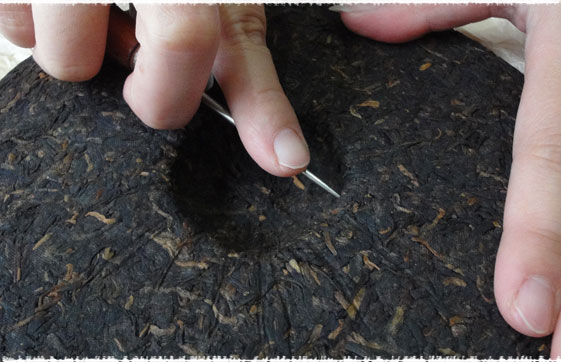

When you find a good place to start your prying, insert your tea needle or tea knife into the bing Pu-erh and shake your hand to loosen the bing up for the first time. Since bing is a more tightly compressed tea, you may need to take more time to insert your tools to pry it loose more easily.
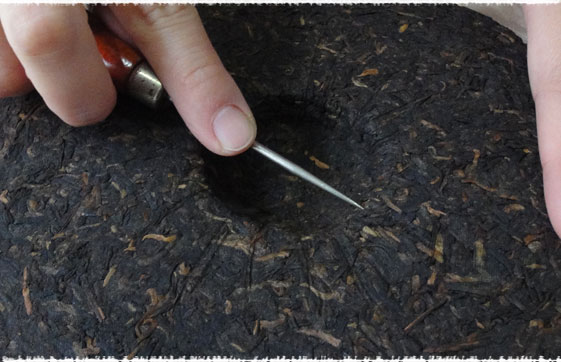
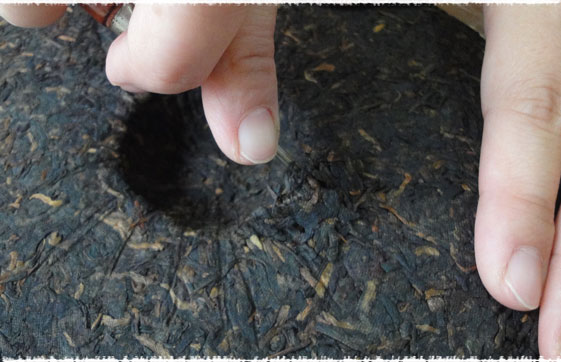
Although you may have to try for a while to get it started to loosen up, you will find that with patience the bing can be loosened properly for the prying loose of the tea. Bing Pu-erh and some of the harder Pu-erh tea bricks are extremely compressed and very tightly compacted, so you may have to be patient yet persistent in loosening your bing Pu-erh so that you can brew a better cup of tea.


Here are some tips for loosening your Pu-erh:
If you choose to pry your Pu-erh tea with a tea needle, please be very careful not to accidentally injure your hand while inserting and prying. If you choose tea needle, you will be careful about your hand. Tuocha is less compressed than bing, so it will be looser and not as stable, and much more easily broken if you use a lot of strength.
It is also much easier to pry loose Pu-erh tea from your tea cake or brick when you make sure that you angle your tea needle perpendicular along the lines of the compressed tea. You should not stick your tea needle directly into the top of the tea, instead use a sideways motion in the direction of the tea flakes.
The methods below are not correct.

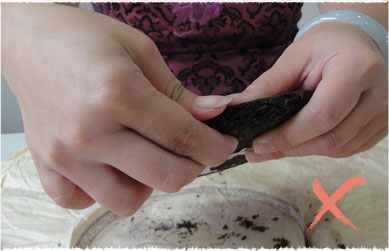
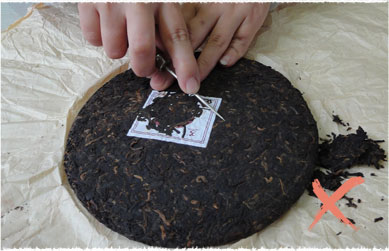
Although it may take you a long time to perfect your prying skills with Pu-erh tea. When you first try prying loose compressed Pu-erh tea, you may break the tea up too much and it may not make a very good cup of tea. However, practice makes perfect, and if you continue to try and hone your Pu-erh prying skills, you will become proficient in prying loose compressed Pu-erh tea in a very short period of time.
Choosing a proper Yixing Clay Teapot for your favorite tea is also one of the most important aspects to reveal outstanding characteristics of your tea. No matter you are addict or just a novice to Yixing Teapot. Get more information about How to Choose a Proper Yixing Teapot for a Single Type of Tea.
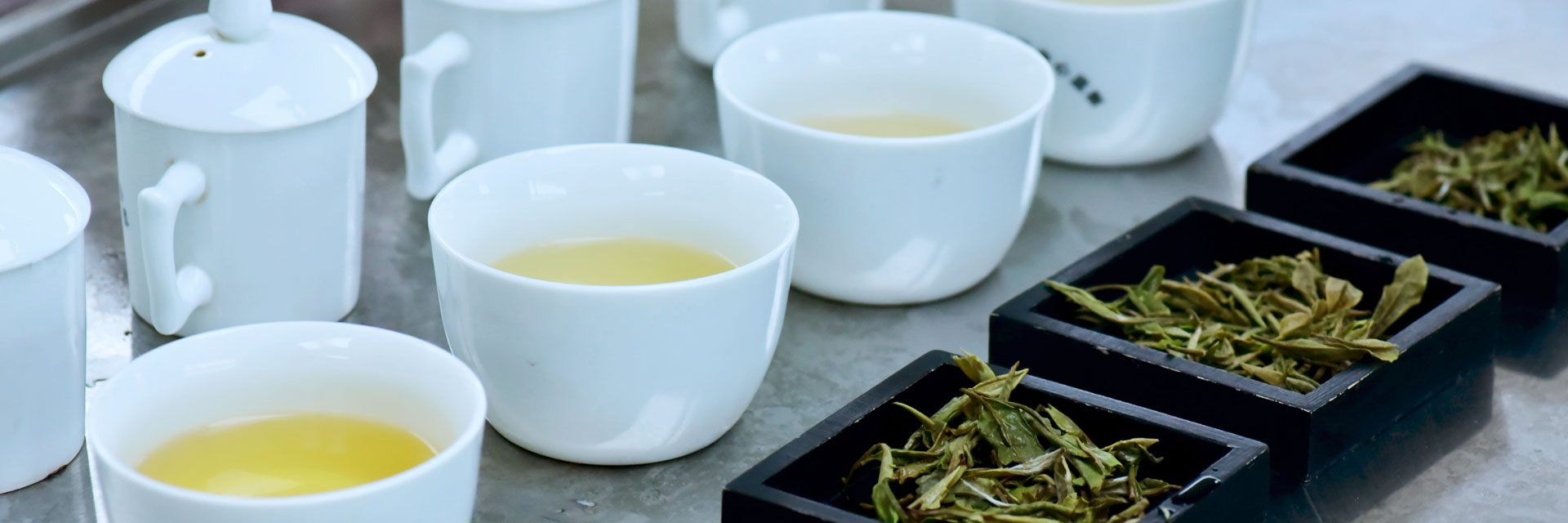 Learn Professional Tea Tasting and Inspection with Tea Master Chen
Learn Professional Tea Tasting and Inspection with Tea Master Chen Yingde Black Tea
Yingde Black Tea Matcha vs. Green Tea Powder
Matcha vs. Green Tea Powder


